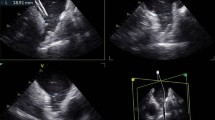Abstract
Purpose
Little is known about the usefulness and safety of vascular closure devices (VCDs) in electrophysiological procedures. We present a retrospective analysis of our experience assessing the utility and outcomes of collagen vascular closure device (Angioseal) in patients that required periprocedural anticoagulation and multiple vascular access sites.
Methods
An retrospective chart review of patients who have undergone the deployment of VCD following electrophysiological procedures.
Results
In 26 patients (16 males, age 57 ± 15 years, weight 96 ± 21 kg), a total of 76 VCD were deployed. Seventy-three VCDs in femoral veins (right or left) and three in femoral artery. The mean number of VCD per patient was 3 (range, 2–4). VCD was successfully deployed in 75 out of 76 access sites. One patient was noted to have ecchymosis in both groins during follow-up visit. No other complications were noted.
Conclusions
We provide evidence that a collagen plug-based VCD designed for arterial closure can be safely and effectively used to close multiple venous accesses even in the same vein. This can be accomplished with a venotomy size up to 2 Fr larger than the size of the closure device.
Similar content being viewed by others
References
Dangas, G., Mehran, R., Kokolis, S., Feldman, D., Satler, L. F., Pichard, A. D., et al. (2001). Vascular complications after percutaneous coronary interventions following hemostasis with manual compression versus arteriotomy closure devices. Journal of the American College of Cardiology, 38(3), 638–641.
Resnic, F. S., Blake, G. J., Ohno-Machado, L., Selwyn, A. P., Popma, J. J., & Rogers, C. (2001). Vascular closure devices and the risk of vascular complications after percutaneous coronary intervention in patients receiving glycoprotein IIb-IIIa inhibitors. American Journal of Cardiology, 88(5), 493–496.
Coto, H. A. (2002). Closure of the femoral vein puncture site after transcatheter procedures using Angio-Seal. Catheterization and Cardiovascular Interventions, 55(1), 16–19.
Shaw, J. A., Dewire, E., Nugent, A., & Eisenhauer, A. C. (2004). Use of suture-mediated vascular closure devices for the management of femoral vein access after transcatheter procedures. Catheterization and Cardiovascular Interventions, 63(4), 439–443.
Hamid, T., Rajagopal, R., Pius, C., Clarke, B., & Mahadevan, V. S. (2013). Preclosure of large-sized venous access sites in adults undergoing transcatheter structural interventions. Catheterization and Cardiovascular Interventions, 81(4), 586–590.
Srivatsa, S. S., Srivatsa, A., & Spangler, T. A. (2015). Mynx vascular closure device achieves reliable closure and hemostasis of percutaneous transfemoral venous access in a porcine vascular model. Journal of Invasive Cardiology, 27(2), 121–127.
Bangard, C., Chang, D. H., Libicher, M., Bovenschulte, H., Kochanek, M., Reuter, H., et al. (2013). Misplacement of central venous catheters in the subclavian artery: Safe retrieval with a percutaneous closure device (AngioSeal). Röfo, 185(6), 546–549.
Mylonas, I., Sakata, Y., Salinger, M., Sanborn, T. A., & Feldman, T. (2006). The use of percutaneous suture-mediated closure for the management of 14 French femoral venous access. Journal of Invasive Cardiology, 18(7), 299–302.
Chu, Y. Q., Cai, L. J., Jiang, D. C., Jia, D., Yan, S. Y., & Wang, Y. Q. (2010). Allergic shock and death associated with protamine administration in a diabetic patient. Clinical Therapeutics, 32(10), 1729–1732.
Chilukuri, K., Henrikson, C. A., Dalal, D., Scherr, D., MacPherson, E. C., Cheng, A., et al. (2009). Incidence and outcomes of protamine reactions in patients undergoing catheter ablation of atrial fibrillation. Journal of Interventional Cardiac Electrophysiology, 25(3), 175–181.
Author information
Authors and Affiliations
Corresponding author
Rights and permissions
About this article
Cite this article
Maraj, I., Budzikowski, A.S., Ali, W. et al. Use of vascular closure device is safe and effective in electrophysiological procedures. J Interv Card Electrophysiol 43, 193–195 (2015). https://doi.org/10.1007/s10840-015-0005-5
Received:
Accepted:
Published:
Issue Date:
DOI: https://doi.org/10.1007/s10840-015-0005-5




